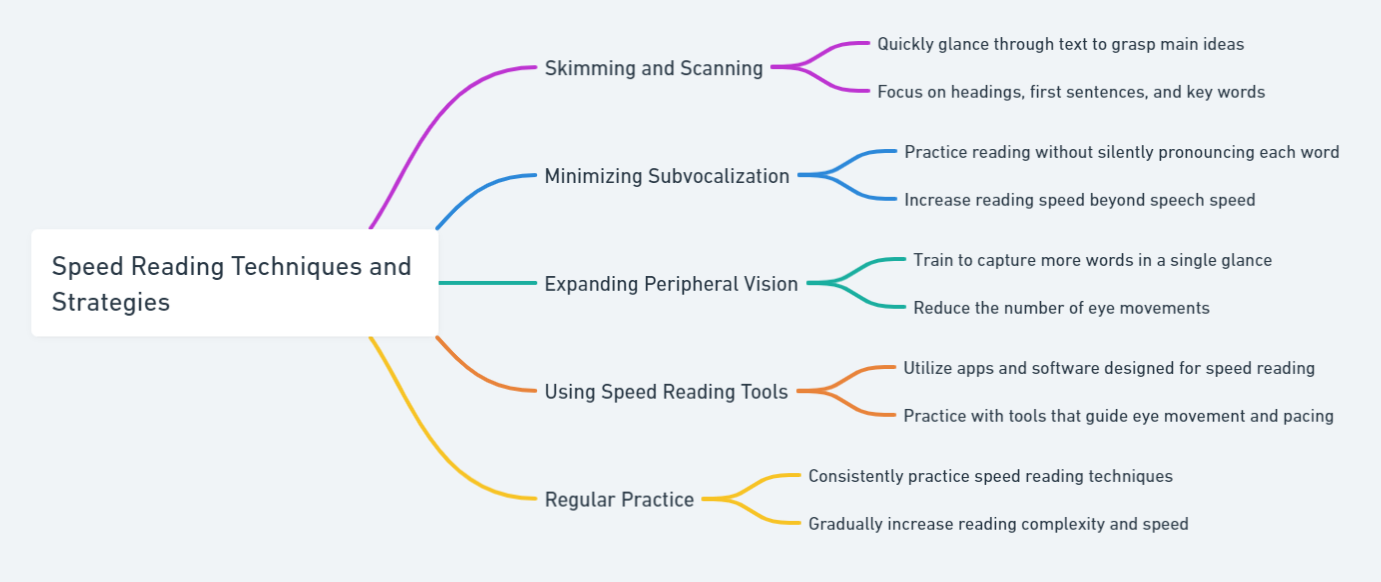Maximizing Efficiency: Proven Techniques to Increase Your Reading Speed
2024-01-30 | By Orcam Staff

Understanding the Basics of Speed Reading
The Science Behind Fast Reading
Speed reading isn't just a skill—it's an art backed by science. At its core, speed reading techniques are designed to enhance your brain's ability to process information quickly and efficiently. This involves training your eyes to move rapidly across a page and training your brain to recognize words and phrases instantly without vocalizing them. It's a way of pushing your cognitive abilities to grasp more in less time.
Research shows that our brains have the capacity to comprehend words much faster than our average reading speed. Speed reading taps into this potential, allowing you to absorb large volumes of text at an accelerated pace. This is achieved through methods like minimizing subvocalization (the habit of silently pronouncing each word in your head as you read) and increasing your peripheral vision to capture more words in a single glance.
Mastering Speed: Key Tips for Faster Reading

In today's fast-paced world, the ability to read quickly and efficiently is more valuable than ever. This is where practical tips for speed reading can make a significant difference. From students and professionals to avid readers, mastering techniques such as skimming and scanning, minimizing subvocalization, expanding peripheral vision, utilizing speed reading tools, and practicing regularly can transform the way you read. These strategies not only enhance your reading speed but also improve comprehension and focus, allowing you to absorb more information in less time.
Whether you're navigating through a dense academic paper or simply enjoying your favorite book, these practical tips offer a pathway to a more efficient and rewarding reading experience. Remember, like any skill, speed reading requires patience and practice. By incorporating these techniques into your daily routine, you'll gradually notice a marked improvement in both your reading pace and your ability to process and retain information.
Practice Skimming and Scanning:
Skimming involves rapidly glancing through the text to grasp the main ideas. It's not about reading every word but getting the gist of the content.
Scanning is about looking for specific information or keywords within the text. This is useful when you need to find particular details without reading the entire content.
Minimize Subvocalization:
Subvocalization is silently pronouncing each word in your head as you read. Minimizing this habit can significantly increase your reading speed. Try focusing on visualizing the concepts or using your finger to guide your reading to break this habit.
Expand Peripheral Vision:
Train your eyes to capture more words in a single glance. This reduces the number of eye movements (saccades) and increases the amount of information processed at once.
Use Speed Reading Apps and Tools:
There are various digital tools designed to enhance reading speed. These tools often present words in a way that encourages faster reading, such as displaying text in rapid succession or guiding eye movement.
Practice Regularly:
Like any skill, improving reading speed requires regular practice. Set aside time each day to practice reading faster, using different types of materials to challenge yourself.
Why These Techniques Work
Cognitive Efficiency: Speed reading techniques train your brain to process information more quickly and efficiently. This enhances cognitive processing and can lead to improved memory and comprehension.
Reduced Cognitive Load: By minimizing subvocalization and expanding peripheral vision, you reduce the cognitive load on your brain. This allows you to process information faster, as the brain doesn't have to work as hard to interpret each word individually.
Better Focus and Comprehension: Contrary to popular belief, speed reading can improve comprehension. Skimming and scanning allow you to focus on key information, which can lead to a deeper understanding of the text.
Time Management: Increasing your reading speed means you can consume more information in less time, which is invaluable in today's fast-paced world where we are constantly bombarded with information.
Adaptability: By practicing various speed reading techniques, you become more adaptable to different types of reading materials and purposes, whether it's quickly going through emails or deeply understanding a complex academic paper.
Remember, increasing your reading speed is a gradual process that requires consistent practice and patience. The key is to find a balance between speed and comprehension, ensuring that you not only read faster but also understand and retain the information you read.
Common Myths about Speed Reading

One of the biggest myths about speed reading is that it always comes at the expense of understanding. While it's true that speed and comprehension are often inversely related, effective speed reading techniques strive to balance the two. It's not just about reading quickly, but also about understanding and retaining the information you read.
Another myth is that speed reading is an innate skill that can't be learned. In reality, with the right techniques and consistent practice, almost anyone can improve their reading speed significantly. It's less about natural ability and more about training your brain and eyes to read in a new way.
Techniques to Enhance Your Reading Speed
Skimming and Scanning Methods
Skimming and scanning are two key techniques in speed reading. Skimming involves quickly moving your eyes over the text to get the gist of the material without reading every word. It's especially useful for identifying the main ideas in a text or for reviewing material you're already familiar with.
Scanning, on the other hand, is about looking for specific information within a text. You're not reading for the overall meaning but searching for keywords or specific pieces of data. Both techniques can significantly increase your reading efficiency, particularly when you're dealing with large volumes of information.
The Role of Eye Movement and Fixation
Eye movement plays a crucial role in speed reading. Traditional reading involves a series of short, choppy eye movements called fixations. Each fixation lasts for about a quarter of a second before your eyes jump to the next set of words. Speed reading techniques aim to reduce the number and duration of these fixations, allowing your eyes to glide smoothly across the page.
Training your eyes to make fewer, longer fixations can dramatically increase your reading speed. This involves expanding your peripheral vision to take in more words at a glance and reducing subvocalization. With practice, you can train your eyes to move more efficiently, taking in larger chunks of text with each fixation.
How Fast Can You Read: Setting Realistic Goals
Assessing Your Current Reading Speed
Before you embark on a journey to increase your reading speed, it's important to know where you're starting from. You can assess your current reading speed by timing yourself while reading a standard piece of text and counting the number of words you read. This gives you a baseline to measure your progress against.
Setting Achievable Targets
Once you know your current reading speed, set realistic and achievable goals for improvement. A common target for speed reading is about 300-700 words per minute, but this varies depending on the individual and the complexity of the text.
It's important to set goals that are challenging yet attainable. Remember, speed reading is a skill that improves over time with practice. Regular training and exercises can help you gradually increase reading speed while maintaining or even improving comprehension.
Tools and Exercises to Boost Reading Efficiency

Interactive Speed Reading Tools
In the digital age, a plethora of interactive tools have been developed to assist in speed reading. These tools often include exercises that train your eyes to move faster and more efficiently across text, as well as techniques to minimize subvocalization. Some popular speed reading software and apps provide a range of activities, from tracking your progress to adapting text presentation for optimal reading speed. They might display words in rapid succession or highlight sections of text to guide your eye movements. These technologies are not only helpful for practicing speed reading but also for keeping you engaged and motivated.
Daily Exercises to Improve Reading Speed
Consistency is key when it comes to enhancing your reading speed. Daily exercises can make a significant difference. Start with simple drills like timing yourself while reading a familiar text and gradually increasing the speed at which you read. You can also practice with different types of material – from novels to technical documents – as this will help you adapt your speed reading skills to various contexts. Other exercises include expanding your peripheral vision by trying to read without fixating on each word, and practicing reading chunks of words or entire sentences at a glance.
The Impact of Reading Speed on Comprehension
Balancing Speed and Understanding
One of the most critical aspects of speed reading is maintaining a balance between the speed of reading and the level of comprehension. It's a common misconception that faster reading always leads to poorer understanding. In reality, efficient speed reading techniques can lead to better comprehension because they discourage word-for-word reading, which often leads to a superficial understanding of the text. By focusing on key ideas and concepts rather than individual words, you can grasp the essence of the text more effectively.
Strategies to Retain More Information

Improving your reading speed doesn't mean much if you're not retaining the information. Some strategies to enhance retention include active reading, where you engage with the text by noting down key points, summarizing sections, or asking questions as you read. Visualization techniques, where you create mental images of what you're reading, can also be effective. Additionally, regularly revisiting and reviewing the material can reinforce what you've read, further aiding in retention. Remember, the goal of speed reading is not just to read fast but to read smart.
Advanced Speed Reading Techniques

Chunking and Pattern Recognition
Advanced speed reading isn't just about reading words faster; it's about understanding and processing information more efficiently. 'Chunking' is a technique where you read groups of words together as a single unit, rather than individually. This approach can significantly increase reading speed because your brain processes information more effectively when it's organized into chunks.
Pattern recognition goes hand in hand with chunking. It involves identifying common structures or patterns in the text, such as familiar phrases, idiomatic expressions, or standard sentence constructions. By recognizing these patterns, your brain can quickly interpret and understand the text, reducing the cognitive load and allowing for faster reading.
Techniques for Complex Materials
Reading complex materials like academic papers or technical documents requires a slightly different approach. Here, it’s crucial to first skim the material to get an overview of the main ideas. Then, focus on the sections that are most relevant to your purpose. You can employ techniques like annotating, making mind maps, or summarizing sections in your own words to deepen your understanding and retention of complex information.
Overcoming Common Challenges in Speed Reading
Dealing with Distractions
Distractions are a major hurdle in speed reading. To minimize them, create a conducive reading environment. This might mean finding a quiet space, turning off notifications on your devices, or setting aside specific times for reading. Also, practicing mindfulness and focusing techniques can help keep your mind from wandering, ensuring that you stay engaged with the material.
Overcoming Mental Barriers
Mental barriers such as self-doubt or a fixed mindset can impede your progress in speed reading. Overcoming these barriers often involves changing your mindset about reading and learning. Understand that speed reading is a skill that improves with practice, and everyone progresses at their own pace. Setting small, achievable goals and celebrating progress can help build confidence and motivation.
Integrating Speed Reading into Your Daily Life

Integrating speed reading into your daily life is about making it a consistent practice. Start by incorporating these techniques into your everyday reading, whether it's emails, news articles, or books. Gradually, as you become more comfortable and proficient, you can apply these methods to more complex texts.
Remember, speed reading is not just a tool for reading faster; it's a way to enhance your overall learning and information processing abilities. By regularly practicing and refining your speed reading skills, you'll not only save time but also gain deeper insights and understanding from the materials you read. The key is to stay patient, be persistent, and enjoy the journey of becoming a more efficient reader and learner.
As you embrace the journey of speed reading, remember that it's not just about how quickly you can read, but also how effectively you can understand and retain information. The integration of speed reading into your daily life is a transformative process that opens up new horizons of learning and efficiency. Whether you're reading emails, news articles, books, or academic papers, applying these techniques consistently will make a significant difference in how you process information.
In this context, OrCam Learn stands out as an innovative tool that complements your speed reading journey. Designed specifically to aid those with learning issues stemming from dyslexia or ADHD, OrCam Learn is a testament to how technology can enhance our learning and reading capabilities. By using OrCam Learn alongside the speed reading techniques discussed in this article, individuals can gain an even greater advantage in their reading and learning endeavors. It's a powerful example of how modern technology and traditional reading skills can come together to create a comprehensive learning experience. This synergy between human skill and technological aid embodies the future of reading and learning, making it an exciting time for avid learners and readers alike.



